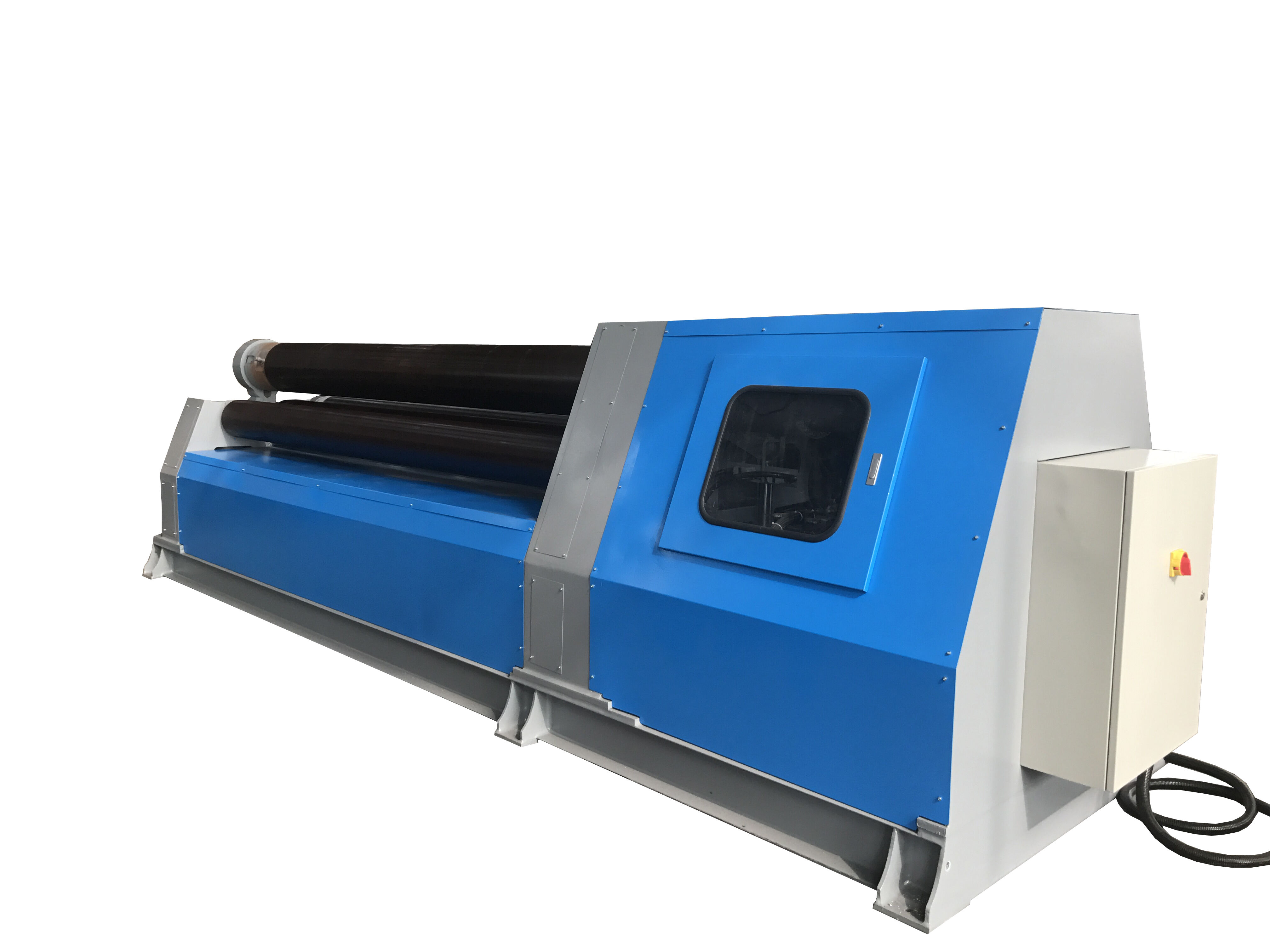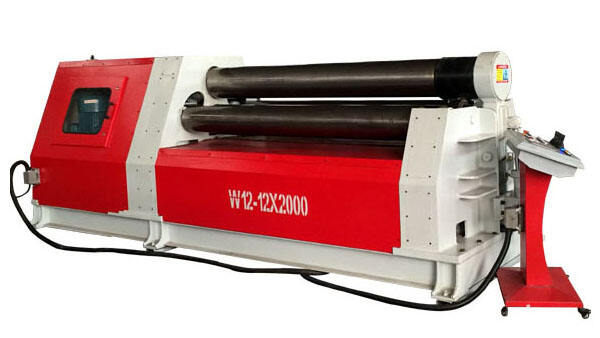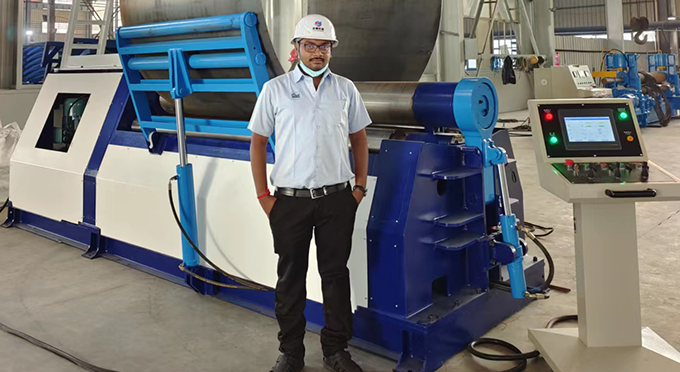How CNC Plate Rolling Machines Enhance Precision and Efficiency in Metal Forming
The Role of CNC Technology in Automating Metal Sheet Bending
CNC tech has really changed how we bend metal sheets these days. Instead of relying on old school methods, it takes those CAD designs and turns them into exact instructions for the machine, so there's no need to manually adjust things like plate thickness or bend radius anymore. The real kicker? These machines can hit angular accuracy down to about 0.1 degrees, which is basically what manufacturers need when making parts for planes or cars where precision matters a lot. Setup times are another big plus point too. Most shops report cutting their preparation work by somewhere between 30 and 50 percent compared to traditional mechanical rollers. And they still manage to keep decent speed going at around 8 to 12 meters per minute even when working with tough materials like stainless steel plates.
Digital Control and Real-Time Monitoring for Consistent Output
Today's CNC plate rollers come equipped with force sensors and angle encoders that keep track of how much the material bends while rolling. The system automatically adjusts hydraulic pressure as needed to counteract springback effects after the roller releases. Shop floor operators can check live readings about roll gap alignment and how torque is distributed throughout the machine using those handy HMIs everyone loves working with. The whole setup creates a feedback loop that maintains around 95 to almost 100% dimensional accuracy between different production runs. Pretty impressive stuff, especially considering it works just as well for tricky jobs like making asymmetrical parts or cone shaped components that used to be real headaches for traditional methods.
Improving Repeatability and Reducing Human Error Through Automation
Modern CNC plate rollers remember the best bending sequences for repeat work, hitting tolerances around 0.05 mm which matters a lot when making thousands of identical parts. These machines come equipped with smart checks that spot issues with material thickness or how fast things are fed into the system even before the rolling starts. For shops working with structural steel, such automated features cut down on wasted material by roughly two thirds to three quarters. That makes all the difference when building things like pressure vessels or turbine casings where getting the curves just right is non negotiable for safety and performance reasons.
CNC Plate Rolling in Heavy-Duty Industrial Sectors: Shipbuilding and Construction
Fabricating Hulls and Pressure Vessels in Shipbuilding with High-Precision Rolls
Modern CNC plate rolling machines can create curved hull sections within about 1.5 mm of dimensional accuracy, which meets most maritime engineering requirements for good hydrodynamic performance. These advanced systems handle 6 inch thick steel plates and shape them into cylindrical parts for pressure vessels, cutting down on those pesky measurement errors that used to hold up around 12% of all fabrication projects. The automated adjustments for crown shaping help maintain consistent curvature throughout those long 40 foot hull sections, making ships more resistant to waves and better able to distribute stress loads evenly across their structures.
Customizing CNC Plate Rollers for Bridge, Tunnel, and Infrastructure Projects
Infrastructure projects require adaptable plate rolling for variable radii—from 3-meter tunnel arches to 100-meter bridge curves. Modern CNC machines deliver this flexibility through:
- Multi-axis synchronization: Coordinates top rolls and side guides for complex geometries
- Material memory: Compensates for springback in high-strength steels like ASTM A572
- Variable thickness handling: Processes plates from 0.5" to 8" without tool changes
A 2023 study of 45 bridge projects found CNC-rolled components reduced fit-up rework by 72% compared to manual methods.
Meeting Structural Demands in Large-Scale Curved Component Manufacturing
CNC plate rolling addresses key challenges in heavy industrial manufacturing:
| Requirement | Manual Method Challenge | CNC Solution | Improvement Factor |
|---|---|---|---|
| 50-ton curved beams | Inconsistent crown pressure | Hydraulic synchronization | 89% repeatability |
| 1/4" tolerance on 30' arcs | Template-based measurement | Laser-guided real-time correction | 0.02" precision |
| Dual-radius transitions | Multiple setup phases | Programmable asymmetric bending | 3X faster cycle |
This capability is vital for rolling 4" thick AR400 steel used in mining equipment, where both impact resistance and precise mating surfaces are required.
Advanced Applications in Aerospace and Renewable Energy Systems
Producing Engine Nacelles and Fuselage Sections in Aerospace Manufacturing
CNC plate rolling machines are able to bend tough stuff like titanium alloys and carbon fiber composites into those complicated curves needed for engine nacelles and fuselage panels. According to some research published last year in the journal Materials, when they make composite nacelles with this CNC rolling method, they tend to last about 15 to maybe even 20 percent longer before showing signs of wear compared to regular sheet metal parts. The machines have really tight controls, down to plus or minus 0.1 millimeter accuracy, which means everything fits together smoothly with the turbine components. This matters because even small problems with airflow around an aircraft can lead to serious money losses over time something manufacturers want to avoid since it costs roughly seven hundred forty thousand dollars each year just on wasted fuel for every single plane affected.
Manufacturing Wind Turbine Towers and Rotor Housings with CNC Precision
CNC plate rollers are making a real difference in the renewable energy sector, especially when it comes to building those massive wind turbine towers that can reach heights of around 160 meters. These machines keep the wall thickness consistent throughout steel plates ranging from about 8 to 40 mm thick. What this means is fewer problems with welds, something that used to hold up offshore projects by roughly 12% due to all the fixes needed. When we look at rotor housings, the CNC automation hits nearly perfect dimensional accuracy at around 99.7%. This level of precision cuts down on drag losses significantly. Without such accuracy, wind farms might lose out on approximately 2.3 terawatt hours of electricity production every year for each thousand turbines installed.
Balancing Lightweight Design and Structural Integrity in Critical Components
When working on aerospace components or energy systems, engineers face the challenge of reducing weight without sacrificing structural integrity. CNC rolling technology has proven invaluable here, creating aluminum-lithium fuselage panels with varying thickness across their surface. These panels achieve impressive results too - around 30% lighter than traditional designs while still hitting those FAA standards for compressive strength at 150 kN per square meter. Looking at another application domain, tidal energy installations benefit from similar innovations. The same CNC process shapes 5083 marine grade aluminum into corrugated supports that stand up against saltwater corrosion for decades, sometimes well past 25 years. And all this comes with material savings of about 18%, which makes these structures both durable and cost effective in the long run.
Transforming Automotive and Heavy Machinery Production with CNC Plate Rolling
Rolling Chassis and Frame Parts with Tight Tolerances for Vehicle Safety
CNC plate rolling creates chassis components with tolerances around ±0.5 mm, which meets most international collision safety requirements. When shaping complex curves from high strength steel or aluminum alloys, the process keeps the material properties intact something that matters a lot for truck frames, electric vehicle battery casings, and similar structural elements. These machines boast about 98.7% repeatable results, so they pretty much get rid of those annoying warping and springback problems that plague traditional manual bending methods. Manufacturers find this particularly valuable when producing parts that need consistent quality across large production runs.
Scaling Production in Automotive Manufacturing Using Automated Plate Rolls
CNC plate rollers that automate the process can slash production time for making curved parts by around 65% when compared to old school hydraulic systems. Top manufacturers have started implementing real time thickness checks so they maintain accurate dimensions even while running at over 12 meters per minute. This lets them keep producing exhaust systems and suspension arms non stop without quality issues. With about 8 out of 10 automotive companies pushing for more automation these days, many CNC plate roller setups now work hand in hand with robots that handle materials automatically. Together they form complete manufacturing cells that run themselves from start to finish, which makes sense for large scale production needs where consistency matters most.
FAQ Section
What is CNC plate rolling?
CNC plate rolling involves using computer numerical control (CNC) technology to automate the bending of metal plates with high precision. It utilizes CAD designs to provide exact instructions to the machinery, enhancing precision and reducing manual errors.
How does CNC plate rolling improve efficiency?
CNC plate rolling machines streamline setup processes, cut preparation times by 30 to 50%, and maintain high-speed production even with robust materials. The technology leads to more efficient workflows compared to traditional methods.
In which industries is CNC plate rolling widely used?
CNC plate rolling is prevalent in industries such as shipbuilding, construction, aerospace, renewable energy, automotive manufacturing, and heavy machinery production, where precision and efficiency are critical.
How does CNC plate rolling benefit the aerospace industry?
In aerospace, CNC plate rolling can shape materials like titanium alloys and carbon fiber composites into complex curves for engine nacelles and fuselage sections, ensuring high precision and reducing wear over time.
Can CNC technology help reduce production waste?
Yes, CNC plate rolling machines equipped with smart checks and automated features significantly minimize material waste by spotting issues early in the process, especially valuable in structural steel applications.
Table of Contents
- How CNC Plate Rolling Machines Enhance Precision and Efficiency in Metal Forming
- CNC Plate Rolling in Heavy-Duty Industrial Sectors: Shipbuilding and Construction
- Advanced Applications in Aerospace and Renewable Energy Systems
- Transforming Automotive and Heavy Machinery Production with CNC Plate Rolling
- FAQ Section




